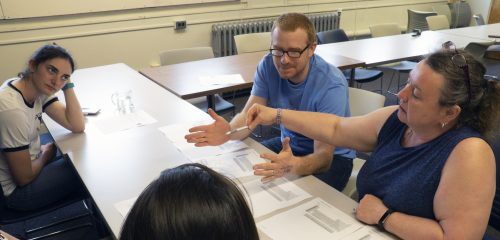Putting the GIRs in Context: Using Climate Science to Teach Chemistry and Biology

ESG Instructor Nick Boekelheide (center) and Lecturer Patti Christie (right) will develop and pilot climate and environmental science modules to lend real-world context to the chemistry and biology GIRs.
All instructors who teach the chemistry and biology GIRs at MIT face a similar challenge: How can you inspire an individual student’s passion for the subject, while also teaching the breadth of concepts in a foundational course? Experimental Study Group (ESG) Lecturer Patti Christie and Instructor Nick Boekelheide will tackle this challenge head-on with ESG’s newest experiment, “Putting the GIRs in context: Using climate science to teach chemistry and Biology.”
Funded by a $49,000 Alumni Class Fund grant, Christie and Boekelheide will develop and pilot climate and environmental science modules for the chemistry and biology GIRs. The modules will show ESG students how the concepts they are taught are connected to actual studies in environmental and climate sciences. By seeing their in-class learning in context, students will be better positioned to understand, retain, and use their GIR learning as they progress in their studies and, later, in their professions.
Christie and Boekelheide are well placed to innovate in teaching the GIRs. With ESG’s small, interactive classes and tight-knit learning community of students and instructors, feedback about course material and teaching technique is thoughtful and immediate. The ESG class structure allows a cycle of course creation, piloting, review, revision, and reimplementation – all within the same year. For this experiment the goal is to have refined modules available for other MIT instructors and on the MITx website in the second year, broadening the reach of this innovation.
MIT undergraduates are enthusiastic learners when inspired, and they are eager to apply their education to transform the world. By incorporating examples of climate and environmental science examples into the chemistry and biology GIRs, we can provide a way for those students to channel their passion into concrete action to change the world they live in.
—Bettina McGimsey, ESG
